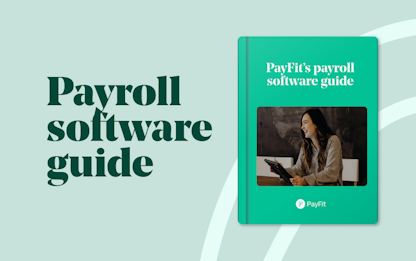- Blog
- |Managing Payroll
- >Payroll data
- >Payroll data
How to Use Payroll Data to Make Better Decisions


To scale any business, you need to understand where your money and energy are going. How much are you spending on expenses? What does your resource allocation look like? Without this data, you’ll struggle to map out which direction the business should take next. The good news? You can get all of this information - what's known as payroll data - directly from payroll software.
Let's explore the question of 'what is payroll data', and how it can support your decision-making when growing your business.
What is payroll data, and why is it useful?
When it comes to the meaning of payroll data, we're referring to all the information you can collect from your payroll process. Examples of payroll data could include salaries, benefits, overtime, annual leave, employee demographics, and anything else related to your employees and their work contracts.
Payroll is more than just paying peoples’ baseline salaries — you can use the data you collect to inform business decisions, from short-term right through to predicted long-term growth.
Running payroll is pretty expensive, so when something costs so much, you want to ensure you’re squeezing every last bit of value out of it. But many companies aren’t doing this. To squeeze all the value out of it, you need to look at how the payroll data you’re collecting (or could be collecting) can contribute positively to your business goals.
And it’s not just accessing the data in the first place that holds value; it’s how you interpret it and use it going forwards. When monitored and measured consistently, this data can help you improve your processes, business performance, employee experience — the list goes on.
Basically, if you’re not fully utilising your payroll data, you’re missing out!
How can you use payroll data in decision-making?
Payroll data holds the power to drive accurate business decisions, which ultimately helps you grow your business. But what does that really mean? How can payroll data help you make these decisions?
Firstly, more accurate data = more knowledge
All data isn’t created equal. In other words, you need accurate financial data to drive business decisions forward. And you can get accurate data by digitising your payroll with a cloud-based software solution. This solution means your data is synced in a central hub and is more accurate than relying on manual data input — i.e. you can kiss goodbye to your spreadsheets.
This way, you can access real-time, reliable data at your fingertips, from wherever you’re working, whether at home or in the office. Moreover, accessing this data whenever you need it means you’re already one step closer to understanding where you're spending money.
Payroll data helps you understand staffing and resource costs
Maybe you’ve got an ageing workforce and need to plan ahead for or to get a handle on overtime costs and understand resource allocation for maximum business output. Payroll data can help you understand all this and more.
This data can help your workforce planning for now and into the future. To adequately manage budgets, you need visibility — payroll data will give you this visibility. Cash flow and cash flow distribution are critical, but you can’t measure what you can’t see.
Use it to sift out payroll errors
Errors are all part of life — we’re human, after all. But one place you don’t want recurring errors or lazy mistakes is in your payroll process.
Payroll is a fundamental part of your business operations — how you process it affects everyone in the organisation. By collecting and analysing payroll data, you can quickly spot patterns in errors, i.e. expenses submitted incorrectly by specific teams or individuals or consistent underpayments/overpayments.
Spotting these errors can help identify critical areas for training and development and help you fine-tune your data collection process in the future.
Improve your employee experience
Retaining talent is something all businesses need to focus on — employers can’t afford to view staff as indispensable with a talent shortage. Instead, your emphasis should be on building an enviable employee experience that delivers value and supports all employees.
You can use payroll data to spot patterns in employee turnover, but by plugging your payroll software into your HR function, you can see an even bigger picture. Assess how your compensation and benefits strategy impacts employee retention and analyse how it also affects staff decisions to leave.
What payroll data can you track with PayFit?
The thought of adding ‘analyse payroll data’ to your to-do list might seem daunting. Good payroll software, however, will support you in generating this data, taking a lot of menial, time-consuming tasks off your plate.
59% of payroll professionals recognise that technological advances would solve problems and allow individuals to focus on more strategic aspects of their role. This is something PayFit can help you achieve. Automating menial tasks means your payroll team can focus on adding value to the business by generating valuable data to drive business strategy.
With that in mind, what payroll data can you access in PayFit?
Salary data
Benchmarking your employee salaries is critical to attracting and retaining the best talent. You want to make sure that you notice any fair pay issues, close the gender pay gap and ensure you’re offering competitive compensation within the marketplace.
Sick leave
Unearthing patterns in sick leave and absences mean you can start to address what’s causing these issues. For example, perhaps productivity is low in specific teams — why is that? Analysing this data can help you improve both employee experience and business performance.
Overtime
Analysing overtime data can be a great indicator of how efficient your business teams are. Why is there so much overtime being logged? Do you need to change how you manage your employees? Is there a productivity problem or perhaps a resource capacity problem? Data allows you to investigate these issues further and put solutions in place before they heavily impact your business goals.
Learn more about how PayFit's reporting feature helps you get to the most insightful data fast.
Integrate with accounting and HR software for a fuller picture
We just mentioned that connecting your HR and accounting software can give you a clearer picture of your employee experience and business costs. Well, this is something you can do with payroll integration from PayFit. In addition, having tech systems that talk to each other means you can access even more data from one place.
Gaining visibility through custom or pre-built reports in your payroll software means you’re better utilising your payroll data to drive business decisions. Business direction should be led by fact, which is what data is — it’s hard evidence. And accessing this information gives you a competitive advantage in your industry. Confidently making strategic decisions without guesswork means you’ve got the upper hand.
Learn more about how PayFit's payroll data solutions can help you make the right decisions for both your team and your business. Book your demo using the link below.


Types Of Flexible Working - A Guide For Employers

What is Flexible Working Within the UK Workplace?

Understanding the Paternity Leave Changes in 2024

International Day of Transgender Visibility Guide

A Guide to 360 Degree Feedback for UK HR Teams

